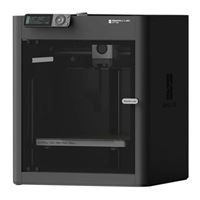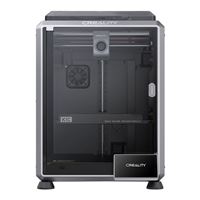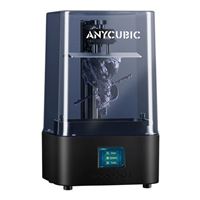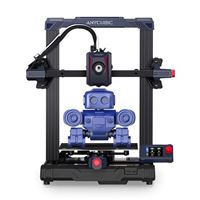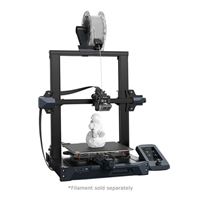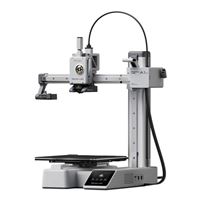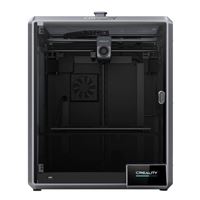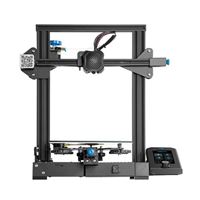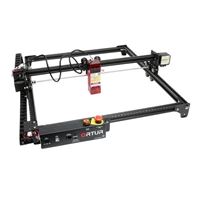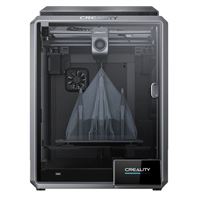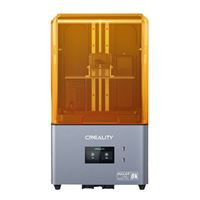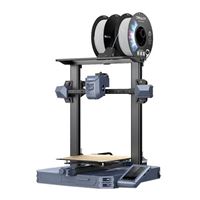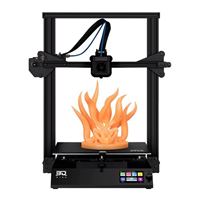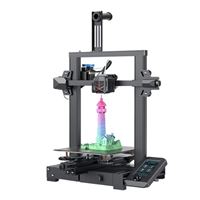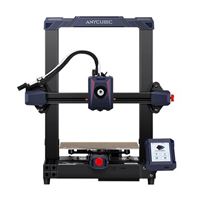Breadcrumbs
- Selected Refinements:
- 3D Printingx
- 3D Printersx
Special Offers / Advertisements
Compare up to 4 items
New list of matching products
X
Sorry, you may compare a maximum of 4 items at a time.
Please clear one or more of your compare items before adding another-
SKU: 580969
- 5" Color LCD Screen
- Automatic Leveling
- Bambu Cool Plate
- 256 x 256 x 256mm Print Size
- 5" Color LCD Screen
- Automatic Leveling
- Bambu Cool Plate
BUY IN STOREOur price $1,449.99 -
SKU: 595389
- 2.8 Monochrome LCD Screen
- Automatic Leveling
- Textured PEI Plate Bed
- 256 x 256 x 256mm Print Size
- 2.8 Monochrome LCD Screen
- Automatic Leveling
- Textured PEI Plate Bed
BUY IN STOREOur price $949.99 -
SKU: 595371
- 2.8 Monochrome LCD Screen
- Automatic Leveling
- Textured PEI Plate Bed
- 256 x 256 x 256mm Print Size
- 2.8 Monochrome LCD Screen
- Automatic Leveling
- Textured PEI Plate Bed
BUY IN STOREOur price $699.99 -
SKU: 599027
- 3.2 Color LCD Screen
- Automatic Leveling
- PC Spring Steel Bed
- 220 x 220 x 250mm Print Size
- 3.2 Color LCD Screen
- Automatic Leveling
- PC Spring Steel Bed
Available for In-Store Pickup Only.Our price $179.99 -
SKU: 622332
- 4.3 Color Touch Screen
- Hands-Free Auto Leveling
- PEI Flexible Bed
- 220 x 220 x 240mm Print Size
- 4.3 Color Touch Screen
- Hands-Free Auto Leveling
- PEI Flexible Bed
Available for In-Store Pickup Only.Our price $259.99 -
SKU: 654194
- 4.3 Color LCD Screen
- Automatic Leveling
- PEI Flexible Build Plate
- 220 x 220 x 250mm Print Size
- 4.3 Color LCD Screen
- Automatic Leveling
- PEI Flexible Build Plate
Available for In-Store Pickup Only.Our price $539.99Original price $559.00Save $19.01 -
SKU: 563122
- 6" Monochrome LCD Screen
- Automatic Leveling
- Laser Engraved Bed
- 165 × 89 x 143mm Print Size
- 6" Monochrome LCD Screen
- Automatic Leveling
- Laser Engraved Bed
Available for In-Store Pickup Only.Our price $139.00 -
SKU: 620153
- 2.4 Color LCD Screen
- Automatic Leveling
- PEl Magnetic Spring Steel Bed
- 220x220x250mm Print Size
- 2.4 Color LCD Screen
- Automatic Leveling
- PEl Magnetic Spring Steel Bed
Available for In-Store Pickup Only.Our price $149.99 -
SKU: 326983
- 4.3 Inch Color LCD Screen
- 32-bit Silent Motherboard
- Magnet Build Surface Plate
- Direct Extruder
- Automatic Bed Leveling
- Dual Z-axis
- Build Volume 220x220x270 mm
- 4.3 Inch Color LCD Screen
- 32-bit Silent Motherboard
- Magnet Build Surface Plate
Available for In-Store Pickup Only.Our price $179.99 -
SKU: 591859
- 10.1 Color LCD Screen
- Automatic Leveling
- Laser Engraving Aluminum Alloy Bed
- 218 x 123 x 200mm Print Size
- 10.1 Color LCD Screen
- Automatic Leveling
- Laser Engraving Aluminum Alloy Bed
Available for In-Store Pickup Only.Our price $399.99 -
SKU: 598748
- 400 x 415mm Print Size
- 400 x 415mm Print Size
Available for In-Store Pickup Only.Our price $999.00Original price $1,199.00Save $200.00 -
SKU: 647180
- 2.4 Color IPS Touch Screen
- Automatic Leveling
- PEI Smooth Bed
- 180 x 180 x 180mm Print Size
- 2.4 Color IPS Touch Screen
- Automatic Leveling
- PEI Smooth Bed
Available for In-Store Pickup Only.Our price $399.99Original price $459.00Save $59.01 -
SKU: 660878
- 2.4 Color IPS Touch Screen
- Automatic Leveling
- PEI Smooth Bed
- 180 x 180 x 180mm Print Size
- 2.4 Color IPS Touch Screen
- Automatic Leveling
- PEI Smooth Bed
Available for In-Store Pickup Only.Our price $249.99Original price $299.00Save $49.01 -
SKU: 578179
- 4.3 Color LCD Screen
- Automatic Leveling
- Flexible Build Plate Bed
- 300 x 300 x 300mm Print Size
- 4.3 Color LCD Screen
- Automatic Leveling
- Flexible Build Plate Bed
Available for In-Store Pickup Only.Our price $699.99Original price $749.00Save $49.01 -
SKU: 110734
- 4.3 Inch Color LCD Screen
- 32-bit Silent Motherboard
- Carborundum Glass Platform
- UL Certified
- Print Resume Function
- 220 x 220 x 250mm Print Size
- 4.3 Inch Color LCD Screen
- 32-bit Silent Motherboard
- Carborundum Glass Platform
Available for In-Store Pickup Only.Our price $149.99Original price $199.00Save $49.01 -
SKU: 506444
- Higher Accuracy Laser
- Bed: 400 x 400mm Print Size
- Higher Accuracy Laser
- Bed: 400 x 400mm Print Size
Available for In-Store Pickup Only.Our price $299.99 -
SKU: 567321
- 4.3 Color LCD Screen
- Automatic Leveling
- Flexible Build Bed
- 220 x 220 x 250mm Print Size
- 4.3 Color LCD Screen
- Automatic Leveling
- Flexible Build Bed
Available for In-Store Pickup Only.Our price $429.99 -
SKU: 598730
- 4.3 Color LCD Screen
- Automatic Leveling
- Quick Release Bed
- 228 x 128 x 230mm Print Size
- 4.3 Color LCD Screen
- Automatic Leveling
- Quick Release Bed
Available for In-Store Pickup Only.Our price $379.99Original price $489.00Save $109.01 -
SKU: 610543
- 4.3 Color LCD Touch Screen
- Automatic Leveling
- PEI Soft Steel Bed
- 220 x 220 x 265mm Print Size
- 4.3 Color LCD Touch Screen
- Automatic Leveling
- PEI Soft Steel Bed
Available for In-Store Pickup Only.Our price $289.99 -
SKU: 325688
- 3.5 Color LCD Screen
- Auto Leveling
- Heated Bed: 124 x 124 x 124 mm Print Size
- 3.5 Color LCD Screen
- Auto Leveling
- Heated Bed: 124 x 124 x 124 mm Print Size
Available for In-Store Pickup Only.Our price $439.99Original price $549.99Save $110.00 -
SKU: 345256
- 3.5 Color LCD Screen
- Auto Leveling
- Heat Bed: 310 x 310 x 340mm Print Size
- 3.5 Color LCD Screen
- Auto Leveling
- Heat Bed: 310 x 310 x 340mm Print Size
Available for In-Store Pickup Only.Our price $159.99Original price $219.99Save $60.00 -
SKU: 554063
- 4.3 Color LCD Screen
- Automatic Leveling
- PC Spring Steel Magnetic Build Plate Bed
- 220 x 220 x 250mm Print Size
- 4.3 Color LCD Screen
- Automatic Leveling
- PC Spring Steel Magnetic Build Plate Bed
Available for In-Store Pickup Only.Our price $179.99Original price $289.00Save $109.01 -
SKU: 592055
- 4.3 Color LCD Screen
- Automatic Leveling
- Laser Engraving Aluminum Alloy Bed
- 220 x 220 x 250mm Print Size
- 4.3 Color LCD Screen
- Automatic Leveling
- Laser Engraving Aluminum Alloy Bed
Available for In-Store Pickup Only.Our price $179.99Original price $279.00Save $99.01 -
Available for In-Store Pickup Only.Our price $299.00
Special Offers / Advertisements
{
'name': 'X1 - Carbon Combo 3D Printer',
'id': '667416',
'price': '1,449.99',
'brand': 'Bambu Lab',
'category': '3D Printers|701',
'list': 'Search Results',
'position': 1
},{
'name': 'P1S Combo (With AMS) 3D Printer',
'id': '668656',
'price': '949.99',
'brand': 'Bambu Lab',
'category': '3D Printers|701',
'list': 'Search Results',
'position': 2
},{
'name': 'P1S 3D Printer',
'id': '668655',
'price': '699.99',
'brand': 'Bambu Lab',
'category': '3D Printers|701',
'list': 'Search Results',
'position': 3
},{
'name': 'Ender-3 V3 SE 3D Printer',
'id': '669326',
'price': '179.99',
'brand': 'Creality',
'category': '3D Printers|701',
'list': 'Search Results',
'position': 4
},{
'name': 'Ender-3 V3 KE 3D Printer',
'id': '672086',
'price': '259.99',
'brand': 'Creality',
'category': '3D Printers|701',
'list': 'Search Results',
'position': 5
},{
'name': 'K1C High Speed 3D Printer',
'id': '675536',
'price': '539.99',
'brand': 'Creality',
'category': '3D Printers|701',
'list': 'Search Results',
'position': 6
},{
'name': 'Photon Mono 2 Resin 3D Printer',
'id': '665567',
'price': '139.00',
'brand': 'AnyCubic',
'category': '3D Printers|701',
'list': 'Search Results',
'position': 7
},{
'name': 'Kobra 2 Neo 3D Printer',
'id': '671220',
'price': '149.99',
'brand': 'AnyCubic',
'category': '3D Printers|701',
'list': 'Search Results',
'position': 8
},{
'name': 'Ender 3 S1 3D Printer',
'id': '642018',
'price': '179.99',
'brand': 'Creality',
'category': '3D Printers|701',
'list': 'Search Results',
'position': 9
},{
'name': 'Photon Mono M5s 3D Resin Printer',
'id': '668454',
'price': '399.99',
'brand': 'AnyCubic',
'category': '3D Printers|701',
'list': 'Search Results',
'position': 10
},{
'name': 'Falcon2 40W Laser Engraver',
'id': '669325',
'price': '999.00',
'brand': 'Creality',
'category': '3D Printers|701',
'list': 'Search Results',
'position': 11
},{
'name': 'A1 mini Combo 3D Printer with AMS lite',
'id': '674680',
'price': '399.99',
'brand': 'Bambu Lab',
'category': '3D Printers|701',
'list': 'Search Results',
'position': 12
},{
'name': 'A1 mini 3D Printer',
'id': '676238',
'price': '249.99',
'brand': 'Bambu Lab',
'category': '3D Printers|701',
'list': 'Search Results',
'position': 13
},{
'name': 'K1 Max FDM 3D Printer',
'id': '667351',
'price': '699.99',
'brand': 'Creality',
'category': '3D Printers|701',
'list': 'Search Results',
'position': 14
},{
'name': 'Ender 3 V2 3D Printer',
'id': '623606',
'price': '149.99',
'brand': 'Creality',
'category': '3D Printers|701',
'list': 'Search Results',
'position': 15
},{
'name': 'Laser Master 2 Pro S2 5.5W Laser Engraver',
'id': '659595',
'price': '299.99',
'brand': '',
'category': '3D Printers|701',
'list': 'Search Results',
'position': 16
},{
'name': 'K1 3D Printer',
'id': '666007',
'price': '429.99',
'brand': 'Creality',
'category': '3D Printers|701',
'list': 'Search Results',
'position': 17
},{
'name': 'CL-103 Halot-Mage Pro 3D Printer',
'id': '669324',
'price': '379.99',
'brand': 'Creality',
'category': '3D Printers|701',
'list': 'Search Results',
'position': 18
},{
'name': 'CR-10 SE 3D Printer',
'id': '670512',
'price': '289.99',
'brand': 'Creality',
'category': '3D Printers|701',
'list': 'Search Results',
'position': 19
},{
'name': '2.0 F350 3D Printer',
'id': '641987',
'price': '439.99',
'brand': 'Snapmaker',
'category': '3D Printers|701',
'list': 'Search Results',
'position': 20
},{
'name': 'B1 SE Plus 3D Printer',
'id': '643191',
'price': '159.99',
'brand': 'BIGTREETECH',
'category': '3D Printers|701',
'list': 'Search Results',
'position': 21
},{
'name': 'Ender-3 V2 Neo 3D Printer',
'id': '664536',
'price': '179.99',
'brand': 'Creality',
'category': '3D Printers|701',
'list': 'Search Results',
'position': 22
},{
'name': 'Kobra 2 FDM 3D Printer',
'id': '668455',
'price': '179.99',
'brand': 'AnyCubic',
'category': '3D Printers|701',
'list': 'Search Results',
'position': 23
},{
'name': 'CL-103L Halot-Mage LCD MSLA 3D Resin Printer',
'id': '664725',
'price': '299.00',
'brand': 'Creality',
'category': '3D Printers|701',
'list': 'Search Results',
'position': 24
}
{'id': 'Banner',
'name': 'Inland Filament Free Shipping',
'creative': 'https://60a99bedadae98078522-a9b6cded92292ef3bace063619038eb1.ssl.cf2.rackcdn.com/images_ads_2022Search_November_FilamentSB.jpg',
'position': '1' }




